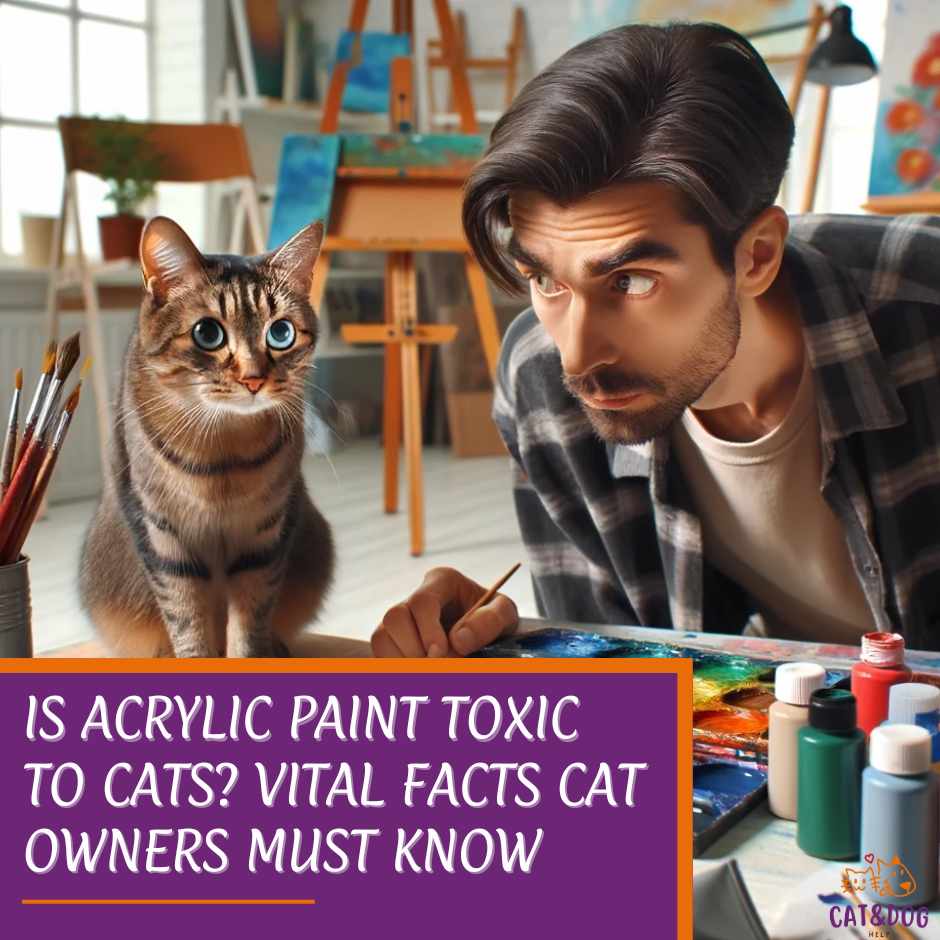You might be wondering, “Is acrylic paint toxic to cats?” Well, it’s a bit of a sticky situation. Generally speaking, acrylic paint isn’t a Grim Reaper to cats.
These water-based paints, including popular varieties like latex and tempera, are not inherently toxic. But before you breathe a sigh of relief and go back to channeling your inner Picasso.
It’s worth noting that not all acrylic paints are created equal. Some do contain chemicals that may not sit well with Mr. Whiskers’ delicate constitution, especially if he decides to turn your palette into an appetizer.
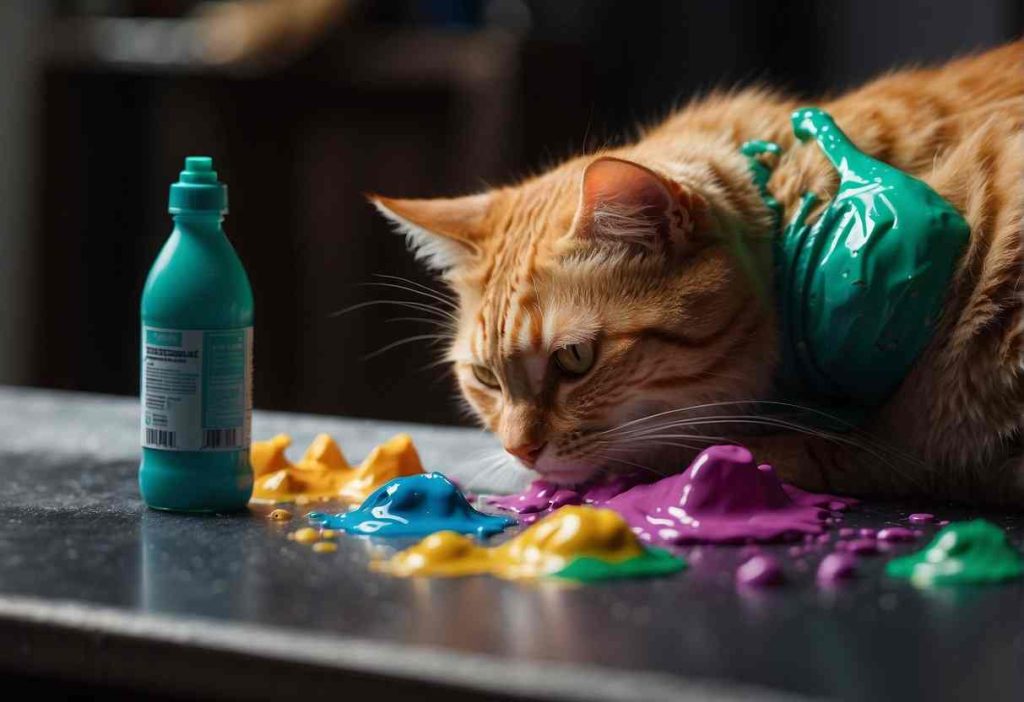
Now, before you put your paintbrush down in a panic, let’s get the facts straight—most cats won’t suffer much from an accidental lick of acrylic paint.
However, the story changes when a large amount of paint is ingested. Gastrointestinal upset is the unwanted guest you might have to deal with in such a scenario, and in extreme cases, it can even lead to liver damage.
And while we’re dabbling in art, let’s not paint all labels with the same brush; ‘non-toxic’ doesn’t always mean pet-safe.
So, if your cat’s curiosity gets the better of them, it’s essential to know how to clean up the mess—literally and figuratively.
In the event of a cat poison emergency, especially if you suspect your cat has ingested a significant amount of acrylic paint, it’s crucial to act swiftly by contacting your veterinarian or the Pet Poison Helpline for immediate guidance.
Key Takeaways
- Acrylic paint is generally safe for cats, but some paints may contain harmful chemicals.
- Ingesting large amounts of acrylic paint can lead to health issues in cats.
- ‘Non-toxic’ labels on paints don’t guarantee they are safe for pets.
Is Acrylic Paint Toxic to Cats?
Licking is a cat’s favorite activity. If there is something that they find strange or has an unfamiliar smell, their curiosity will usually increase.
Most acrylic paints are labeled non-toxic, which is reassuring. But hey, let’s not forget that ‘non-toxic’ isn’t an open invitation for your kitty to host a paint-tasting party.
If they gobble up a paint tube or even take a sip of paint water, it’s not the same as a cheeky lick of whipped cream.
Understanding Acrylic Paint Toxicity
- Non-toxic labels – Acrylic paints are commonly labeled non-toxic, suggesting they’re safe for the household.
- Hidden risks – Despite this, ingesting large amounts can be risky due to the chemicals not meant for a cat’s belly.
Ever wonder what the ASPCA would say?
They’ve listed paint as a bit of a nuisance on their potential toxin list. And they know a thing or two about what shouldn’t end up in a cat’s tummy.
The risk meter bounces around based on the composition of the paint, like that art project you’re not quite sure about.
However, it’s important to note that certain types of paint, such as lead-based or acrylic paint, can be toxic to cats.
Something toxic may cause symptoms such as vomiting, diarrhea, weakness, and increased heart rate.
While a few licks of paint might not seem like a big deal, it can be quite dangerous for your feline friend.
Symptoms of Paint Toxicity in Cats
- If things go south, your cat might show signs like:
Luna’s Paint Adventure – A Case Study Picture this: Luna, a charismatic cat, decides acrylic paint is her snack of choice. Roll forward to the aftermath, and she’s one lethargic furball with a stomach doing cartwheels.
Luna needed her human to whisk her off to the vet pronto for some much-needed care after her artistic escapade in 2019. Luna’s tale is a stark reminder that an ounce of prevention is worth a pound of cure.
Expert Opinions and Case Studies
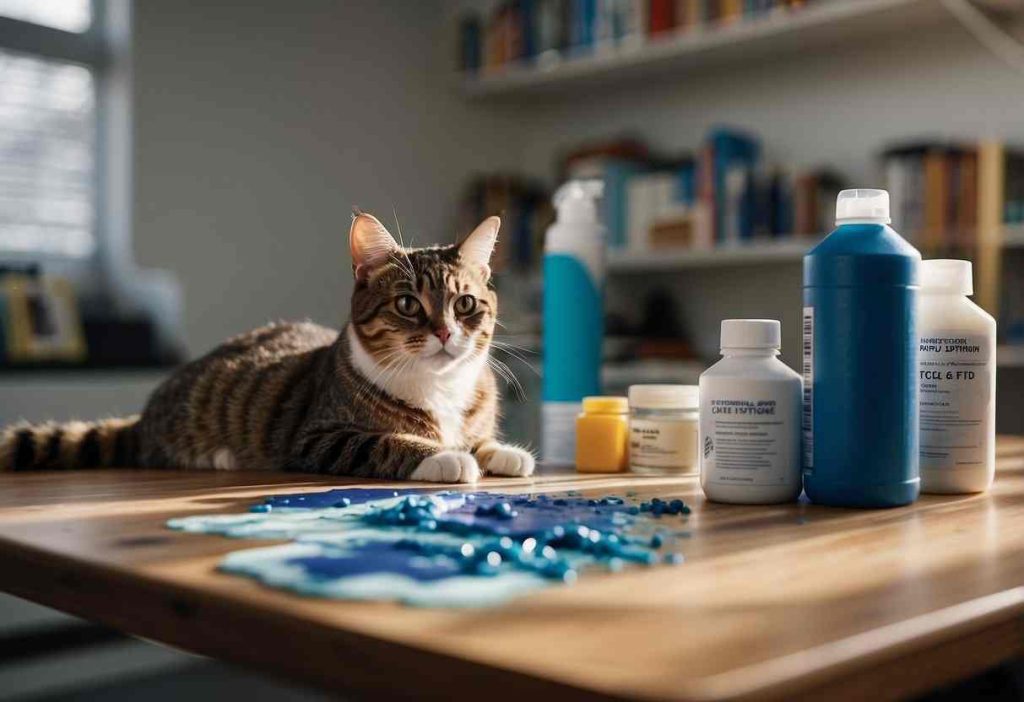
Dr. Jane Smith, a veterinary toxicologist, has some thoughts. “While small ingestions of acrylic paint are rarely lethal, the risk remains for gastrointestinal upset, and in rarer cases, respiratory issues,” explains Dr. Smith.
So, should you panic the next time your kitty’s curiosity peaks around your art project?
Probably not, but it’s wise to err on the side of caution and consult your veterinarian for expert advice on treatment for paint ingestion.
In an interesting turn, the Journal of Veterinary Medicine revealed that our furry companions are at risk of developing respiratory issues if they’re too frisky around freshly painted surfaces.
This highlights the importance of keeping those curious paws away from your artwork. Here’s a helpful breakdown:
Professional Validation:
- Risks: Gastrointestinal upset, respiratory discomfort.
- Dr. Smith’s Quotes: “Rarely lethal,” but precautions are necessary.
Recommended Actions from Experts:
- Store art supplies out of paws’ reach.
- Ventilate the room while painting.
- Immediate Consultation: If you suspect your cat got into the paint, chatting with a vet posthaste is a smart move.
Caught your cat in the act? Dr. Smith advises, “If you think your cat has ingested acrylic paint, offering a light meal and water may help dilute the substance, but always consult a vet.”
Remember, the right choice is prevention. Keep those rainbows of tubes and brushes contained, and let’s keep those fuzzy friends safe.
Pay attention to the placement of items that are not pet-friendly. It is better to prevent your cat from licking items than to treat them.
After all, isn’t a healthy cat the perfect companion to cheer you on as you create your next masterpiece?
Safety Precautions for Using Acrylic Paint Around Cats
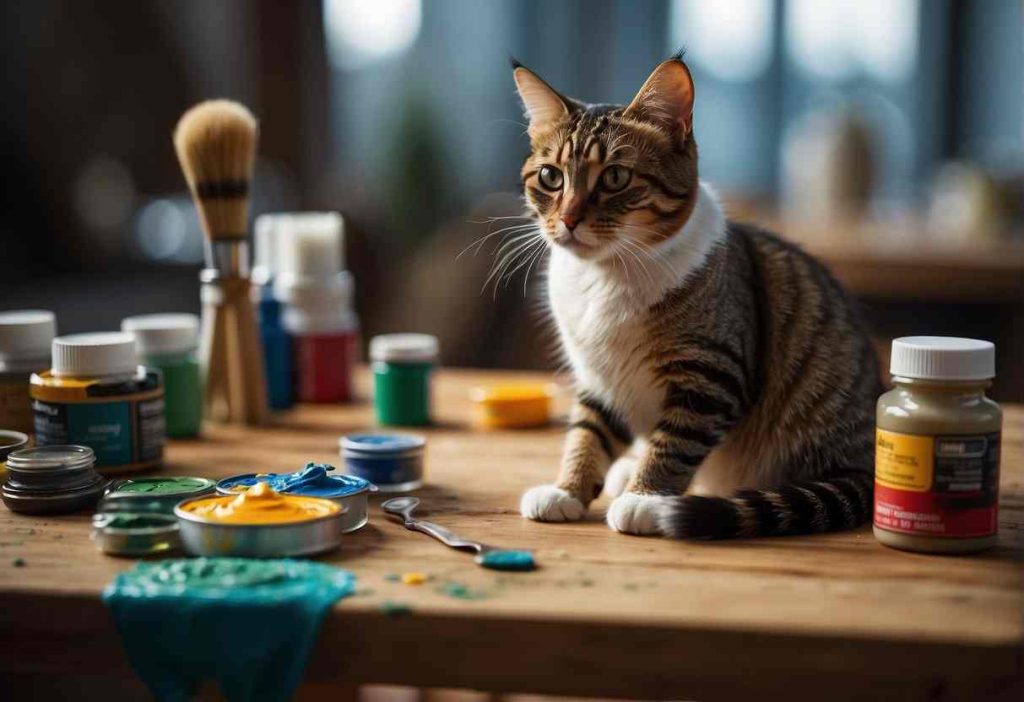
Preventing Exposure Curious cats and paint don’t mix well. Keep a few tricks up your sleeve to keep your pet safe:
- Secure Storage: Always use containers with tight-fitting lids, place them out of paw’s reach—atop high shelves, perhaps?—and make sure the painting room is a cat-free zone.
- Ventilation is Vital: While your creativity flows, so should the air. Crack open the windows and let a fan circulate the breeze. It helps whisk away any potentially harmful fumes, keeping both you and your purring pal in top-notch health.
Safe Painting Practices Just like cat-proofing your home, you can cat-proof your painting:
- Pet-Safe Paints: On the hunt for the perfect hue? Go the extra mile with brands like “Eco-Pet Paint”—specially concocted to be safe for your four-legged sidekick.
- Clean as a Whisker: Accidents happen, but speedy cleanup ensures your pet doesn’t treat spills as a snack. Wipe up paint splatters immediately to avoid any curious tongues or paws coming into contact with them.
Remember, while most acrylic paints are generally safe, some colors may have hidden nasties. Always check labels for any toxic ingredients.
Be your cat’s hero by staying informed and taking these simple precautions. Happy painting, and may your feline muse inspire rather than ingest your art!
What to Do If Your Cat Is Exposed to Acrylic Paint
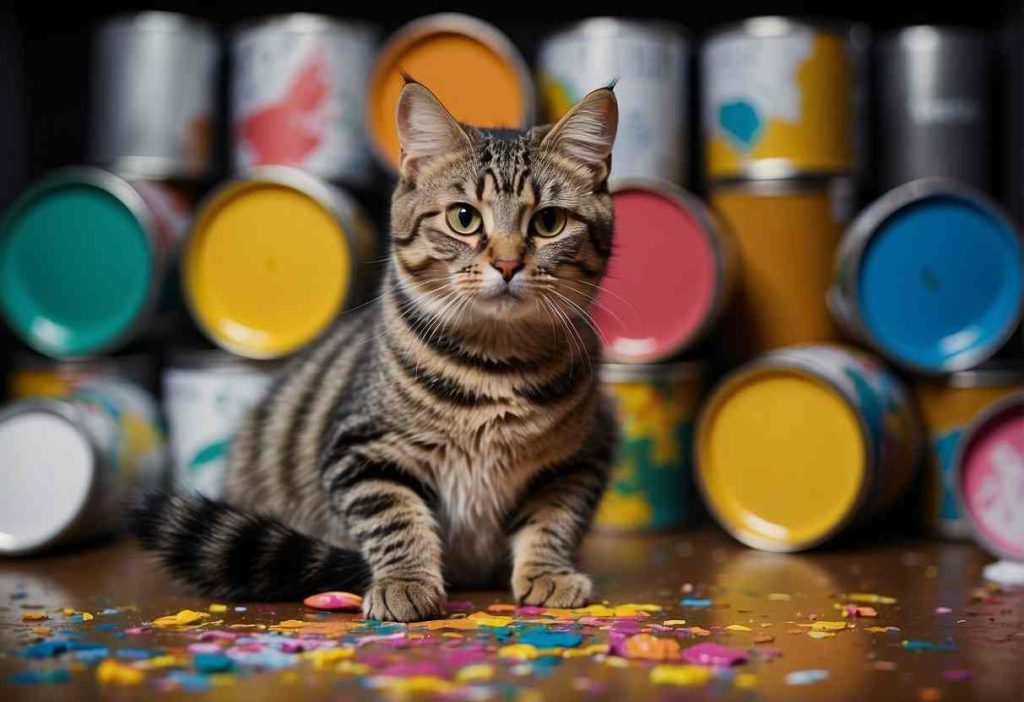
Immediate Steps and Cleaning
First things first, check to see how much paint your cat has gotten into. A little paint on their fur? Not a huge deal. If you spot paint, here’s a cat-friendly clean-up routine:
- Stay Calm: Your cat will pick up on your mood, so take a deep breath.
- Gather Supplies: Mild soap and lukewarm water will be your best friends.
- Gentle Cleaning:
- Rub-a-dub: Gently wash the paint from your cat’s fur.
- No No’s: Avoid harsh chemicals or cold water which can cause more irritation.
After the initial cleanup, keep an eye out for any odd behavior like scratching or pawing at their face. It’s like a detective game but with more cuddles while you monitor for any reactions.
Seeking Veterinary Care
If your cat acted as a paintbrush and got more than just a smudge of paint on them, it’s time to call in the pros:
- Ring, Ring! Your first call should be to your vet or the Pet Poison Helpline.
- Details Matter: Tell them what kind of paint it was and estimate how much your cat was exposed to.
Treatment can vary, but here’s what might be on the vet’s menu:
- Activated Charcoal: Great for adsorbing ingested toxins. (5)
- IV Fluids: For any kitty dehydration. (6)
- Supportive Care: For all the other symptoms that might pop up.
Remember, your vet’s advice trumps all, so follow their instructions to the letter. Your cat’s health is the masterpiece we’re all aiming to protect!
Deep Dive into Non-Toxic Labels and VOCs
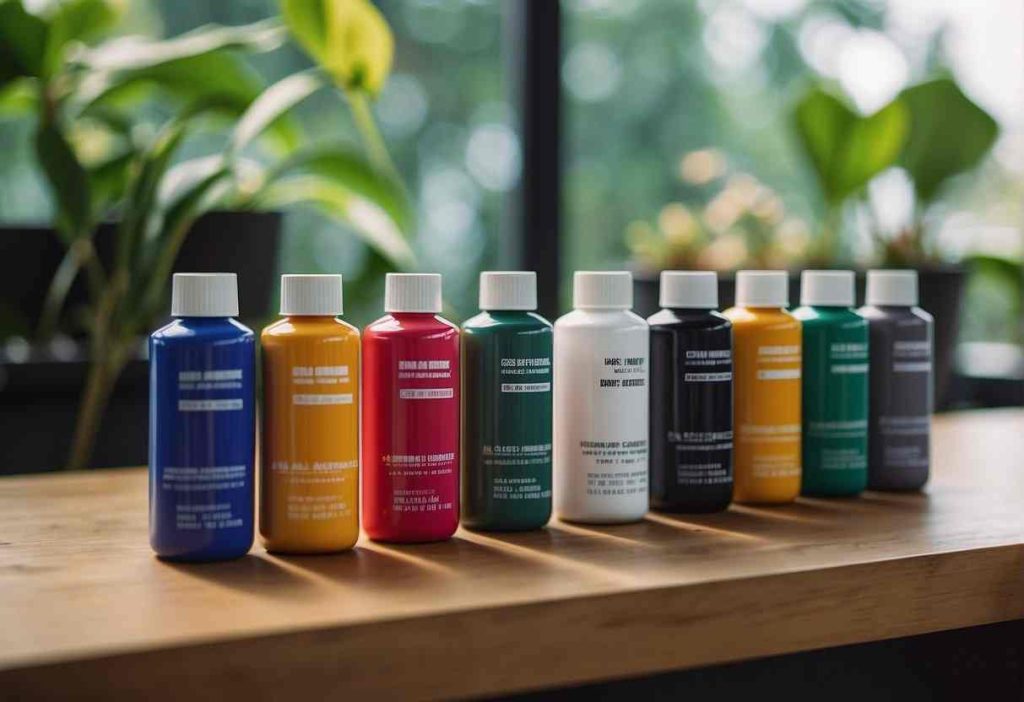
The “non-toxic” stamp often comes from a certification like ASTM D4236, meaning some smart toxicologists have given it the thumbs up for humans.
Ever heard of VOCs? These are Volatile Organic Compounds, not some secret villain organization – but they can be somewhat sinister. (7)
These chemical compounds vaporize at room temperature, and sniffing them isn’t exactly a day at the spa. They can cause a parade of nuisances, from eye irritation to headaches.
And we’re not just talking about a bad day; long-term exposure can lead to more troubling issues.
So, what’s the deal with paints and your purring pal? Ideally, choose paints with low to zero VOCs. Gone are the days of paint fumes being a bonus to your redecorating adventure.
Nowadays, choices like Green Seal-certified paints are your best bet for a safer environment – and not just for the planet, but for your cuddly companions at home.
Here’s a quick rundown:
- Non-toxic paints: Safe for human touch
- Not an all-clear for pets
- Often backed by ASTM D4236
- VOCs: Can cause nose, throat, eye irritation, etc.
- Look for low-VOC or zero-VOC products
Remember, just because it’s okay for you doesn’t mean it’s a green light for your four-legged friends to bathe in it.
Keep a lookout for those labels and always think about the well-being of your pets when making paint choices!
Choosing Cat-Safe Paints and Alternatives
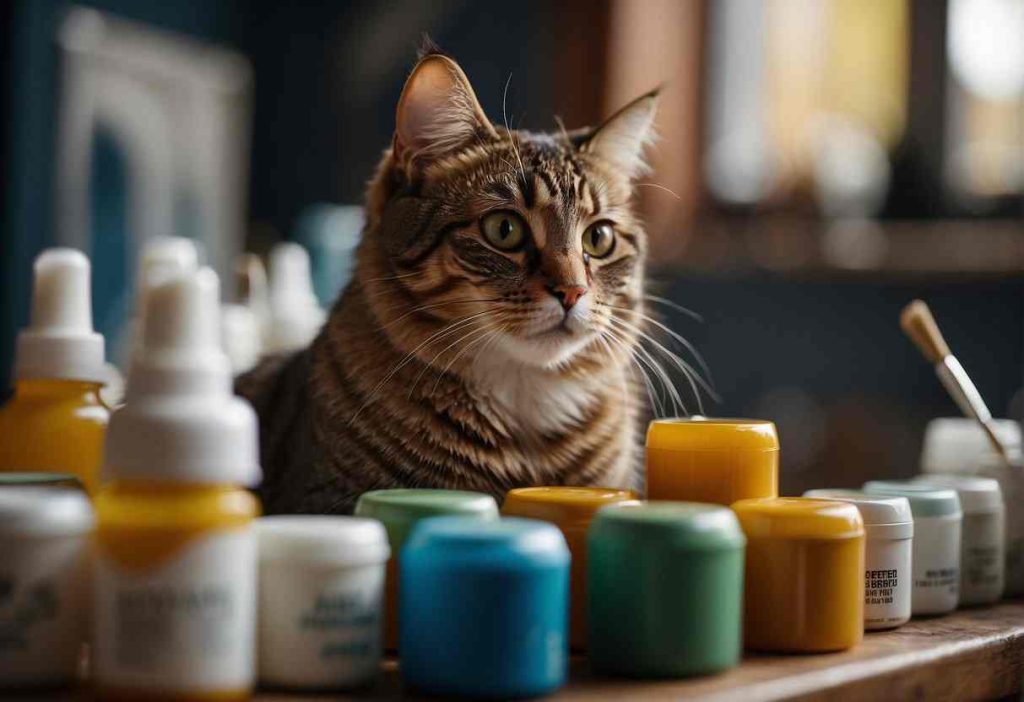
Non-Toxic Paint Options for Pet Owners: Finding the right paint can be a bit of a treasure hunt, but not to worry! Look for water-based paints like “Liquitex Basics” or latex paints.
Which offers a non-toxic range that’s purr-fect for households with curious kitties. Keep an eye out for other low-VOC, non-toxic certified brands such as artist paints at your local art store or online.
- Brands to consider: Liquitex Basics
- Crayola Washable Paints
- Prang Watercolor Paint
Natural Alternatives: If you’re feeling adventurous, why not DIY your paint? Mix food coloring or vegetable dyes with kitchen ingredients to create custom, cat-safe colors.
- Homemade paint ideas: Food coloring + cornstarch
- Vegetable dyes + flour
Tips for Pet-Friendly Art Projects: Involve your kitty in the fun with pet-safe ink pads for a paw print masterpiece. Just make sure to wash those paws thoroughly afterward to avoid any accidental ingestion.
And remember, supervision is key! Keep an eye on your furry Picasso to ensure they’re not feasting on your art supplies.
- Safe art activities: Paw print art with non-toxic ink pads
- Collages with pet-friendly glue
By choosing the right products and keeping a watchful eye, you and your kitty can enjoy a creative, stress-free, and safe environment.
Now go unleash that inner artist, and perhaps you’ll discover your cat’s hidden talents too!
Potential Health Risks for Cats
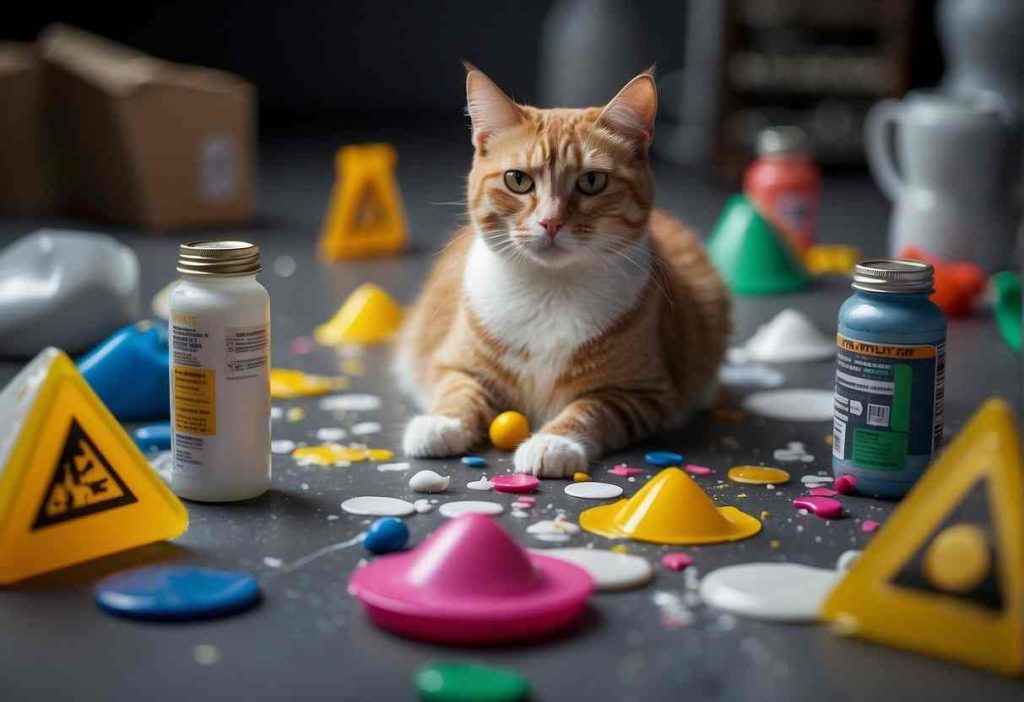
Short-Term Risks:
- Skin Irritation: If your kitty gets paint on their skin or fur, it might irritate. (8)
- Gastrointestinal Upset: A curious cat might lick some paint, leading to vomiting or diarrhea in small doses. (9)
Please Note: If you ever see your cat ingesting paint, a check with the vet is a smart move!
Now, regarding those long-term effects, the truth is, that we don’t have a cat-specific study that shouts out clear risks.
However, we know that repeated chemical exposure isn’t anyone’s friend – two-legged or four-legged!
Studies relative to humans suggest chronic exposure to paint chemicals, such as lead paint and cadmium, can be harmful, so why take the chance with your cat?
Preventative Measures:
- Safe Painting: Use non-toxic paints.
- Clean Up: Keep your painting supplies away from prying paws.
- Ventilation: Always paint in a well-ventilated area to avoid fume buildup.
Think of your cat’s well-being, and keep those paint sessions safe. Cats are small creatures, and it doesn’t take much to cause them harm. Stay informed, stay aware, and keep painting without worry!
Quick Recap
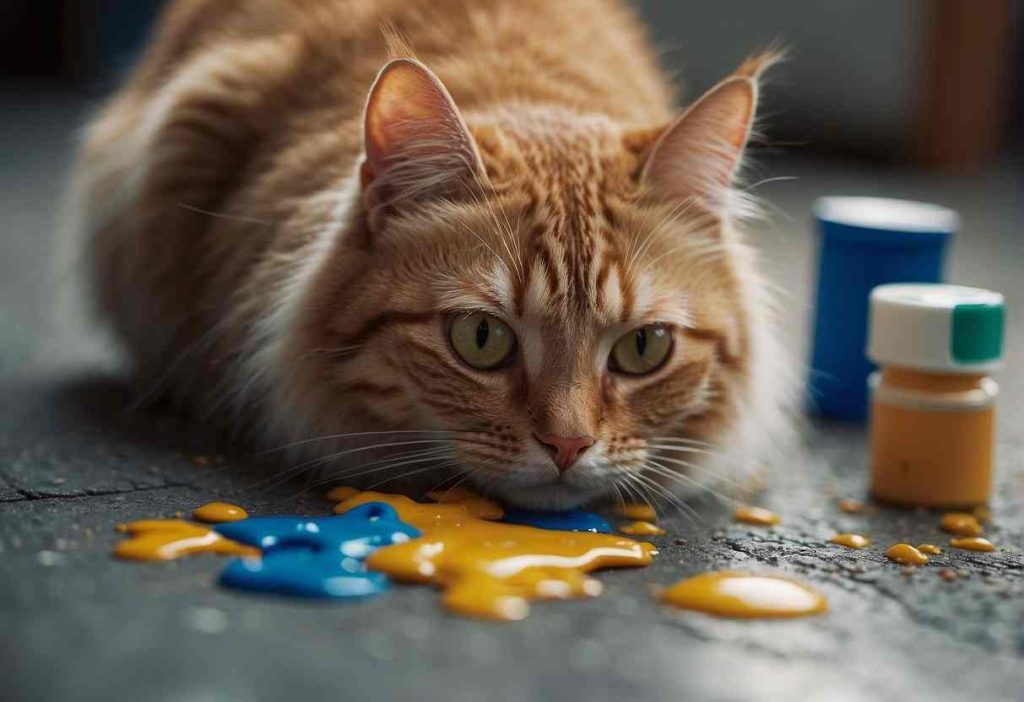
Remember to use non-toxic paints and cover finished projects with a sealant, like shellac or varnish, to ensure your cat’s safety. Always clean up any spilled paint and don’t leave it unattended.
Be aware of any acute health risks and signs that your cat may have been exposed to harmful substances, such as excessive drooling.
If exposed, seek immediate medical attention from a qualified veterinarian. With these precautions, you can safely use acrylic paint around your beloved feline friend.
- Safe, But…: Acrylic paints aren’t typically toxic to cats. However, specific colors may have toxic additives, so always read labels before use.
- Allergies and Irritations: Even non-toxic paints can bother your cat. If you spot your kitty scratching after an art-session encounter, it may be an allergic reaction or skin irritation.
- Ingestion: Accidents happen, and sometimes cats get curious. Small amounts of acrylic paint should not cause harm, but it’s best to prevent any lick-testing.
- Breathing Space: Airbrushing or sanding? Large amounts of fine paint particles in the air are a no-go for you and your cat. Keep them at arm’s (or paw’s) length.
- On Guard: Cover up any painting areas and store away your supplies post-use. Cured paint is less of a risk, but it’s best to keep wet paint out of paw’s reach.
Remember, while creating your masterpiece, your furry critter’s safety is the real work of art.
If your cat decides to explore your palette, promptly clean off any paint, and consult a vet if you’re worried about any reactions.
Didn’t catch any of that? No worries! Just think, “Safety first,” and you’ll be in great shape. Keep those paint tubes sealed, and you’ll both be just fine—happy painting!
Frequently Asked Questions
When your furry friend is involved, safety comes first. So, let’s dig into those pressing questions you might have about cats and acrylic paint without any beating around the bush.
What should I do immediately if my cat ingests acrylic paint?
If you catch your cat in the act of sampling some acrylic paint, don’t panic.
Immediately remove any leftover paint from their mouth, and offer water to help dilute the substance.
Then, contact your vet pronto, especially if you notice any unusual behavior.
How can I tell if my cat has been poisoned by acrylic paint?
Keep an eye out for symptoms like vomiting, diarrhea, appetite loss, coughing, or difficulty breathing.
These are red flags that your feline may have acrylic paint poisoning. Always trust your gut—if something seems off, a vet visit is a smart move.
Can cats recover from acrylic paint poisoning?
Sure thing! Most cats can bounce back from acrylic paint poisoning with prompt and appropriate care.
Recovery depends on the amount of paint ingested and how quickly you seek veterinary help.
Follow your vet’s guidance to the letter for the best shot at a full recovery.
Is it safe to paint a cat’s paws for art projects?
While it might look cute, it’s risky to use any paint on your cat’s paws unless it’s specifically made to be pet-friendly.
Stick to non-toxic, pet-safe paints to avoid any health scares and keep your art projects fun for both you and your kitty.
Can fumes from painting with acrylics be harmful to cats?
Those fumes aren’t a joke.
Acrylic paint fumes can irritate your cat’s lungs, causing coughing or wheezing, and it’s best to keep your pet in a well-ventilated space away from your art antics.
Better safe than sorry!

